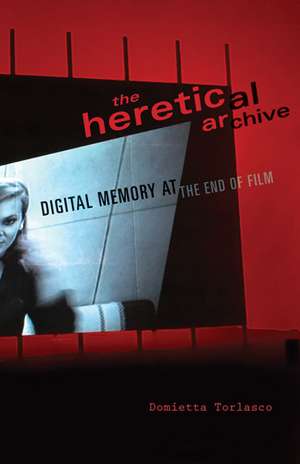The Heretical Archive: Digital Memory at the End of Film
Autor Domietta Torlascoen Limba Engleză Paperback – 5 mar 2013
The Heretical Archive examines the relationship between memory and creation in contemporary artworks that use digital technology while appropriating film materials. Domietta Torlasco argues that these digital films and multimedia installations radically transform our memory of cinema and our understanding of the archive. Indeed, such works define a notion of archiving not as the passive preservation of audiovisual signs but as an intervention and the creative rearticulation of cinema’s perceptual and political textures.
Connecting psychoanalysis, phenomenology, and feminist theory in innovative ways, Torlasco analyzes cutting-edge digital works that engage with the past of European cinema and visual culture, including video installations by Monica Bonvicini (Destroy She Said) and Pierre Huyghe (The Ellipsis), Agnès Varda’s film The Gleaners and I, Marco Poloni’s multimedia installation The Desert Room, and Chris Marker’s CD-ROM Immemory.
Torlasco’s central claim is that if the archives of psychoanalysis and cinema have long privileged the lineage that runs from Oedipus to Freud, the archives of the digital age—what she calls the “heretical archive”—can help us imagine an unruly, porous, multifaceted legacy, one in which marginal figures return to speak of lost life as much as of life that demands to be lived.
Preț: 112.78 lei
Preț vechi: 153.91 lei
-27% Nou
Puncte Express: 169
Preț estimativ în valută:
21.58€ • 22.45$ • 17.82£
21.58€ • 22.45$ • 17.82£
Carte indisponibilă temporar
Doresc să fiu notificat când acest titlu va fi disponibil:
Se trimite...
Preluare comenzi: 021 569.72.76
Specificații
ISBN-13: 9780816681105
ISBN-10: 0816681104
Pagini: 160
Ilustrații: 25
Dimensiuni: 140 x 216 x 15 mm
Greutate: 0.23 kg
Ediția:1
Editura: University of Minnesota Press
Colecția Univ Of Minnesota Press
ISBN-10: 0816681104
Pagini: 160
Ilustrații: 25
Dimensiuni: 140 x 216 x 15 mm
Greutate: 0.23 kg
Ediția:1
Editura: University of Minnesota Press
Colecția Univ Of Minnesota Press
Notă biografică
Domietta Torlasco is associate professor of French and Italian and comparative literary studies at Northwestern University. She is the creator of the digital film Antigone’s Noir and the author of The Time of the Crime: Phenomenology, Psychoanalysis, Italian Film.
Cuprins
Contents
Acknowledgments
Introduction
1. Against House Arrest: Antigone and the Impurity of the Death Drive
2. Digital Impressions: Writing Memory after Agnès Varda
3. Folding Time: Toward a New Theory of Montage
4. Archiving Disappearance: From Michelangelo Antonioni to New Media
Notes
Index
Recenzii
"Inspired by other scholars who have brought the phenomenological method to cinema, Domietta Torlasco writes beautifully of her own encounters with films and images, drawing the reader into her own vision as she elucidates its implication in a constellation of deep thought. The book’s insights are as fresh and profound as its writing, in other words: at its best moments, it is a real tour de force that is an extended reflection rather than a series of discrete observations." —Amy Villarejo, author of Film Studies: The Basics
"Digital technology allows once quiescent cinemagoers to dismantle and refashion previously inviolable products of the film industry. Torlasco sees the potential for politically transformative thinking in such acts. She argues that our capacity to imagine alternative futures may depend on our ability to reconfigure the virtual archive of filmic memory. Part philosophical reflection, part manifesto, Torlasco's book is essential reading for anyone wishing to steer a critical theory of audiovisual art between the Scylla and Charybdis of technophilia and artworldspeak. " —Victor Burgin, author of The Remembered Film
Descriere
In The Heretical Archive, Domietta Torlasco examines the relationship between memory and creation in contemporary artworks that use digital technology while appropriating film materials. Connecting psychoanalysis, phenomenology, and feminist theory in innovative ways, Torlasco argues that these digital films and multimedia installations radically transform our memory of cinema and our understanding of the archive.
